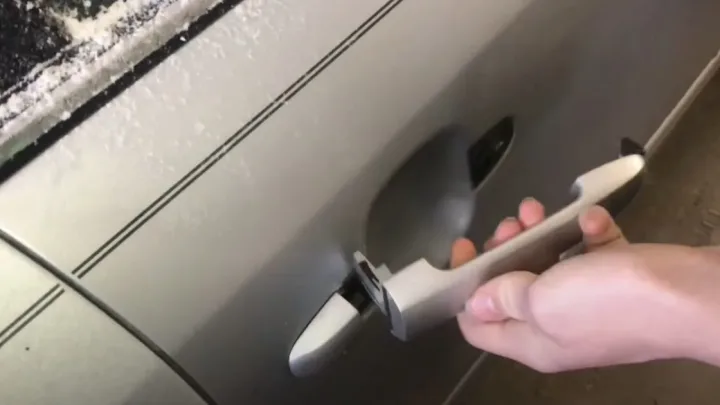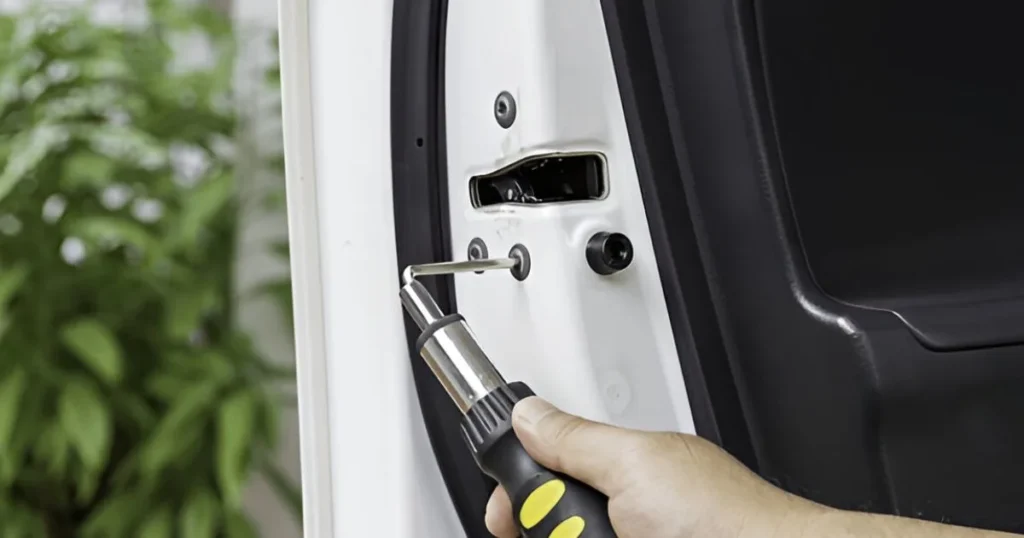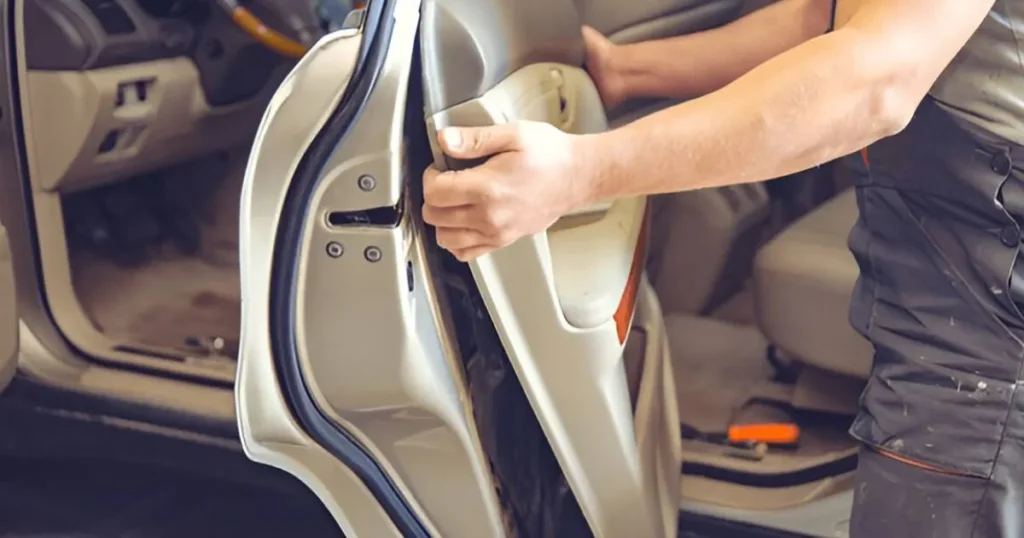
A car door latch may be broken if the door won't close properly or makes unusual noises. Difficulty locking or unlocking the door also indicates a problem.
Ensuring your vehicle's security and functionality hinges on every component working seamlessly, including the seemingly minor car door latch. This small yet crucial part plays a significant role in your car's overall safety and convenience. A malfunctioning latch not only jeopardizes the security of your vehicle but also compromises the safety of its occupants.
Recognizing the early signs of a broken car door latch can save you from potential inconveniences and costly repairs down the line. Regular inspections and prompt attention to any irregularities can keep your car's door mechanism in top condition, ensuring a smooth and safe driving experience.
Signs Of A Faulty Car Door Latch
A car door latch holds the door closed. Over time, latches can fail. Knowing the signs can save time and ensure safety. Let's explore these signs.
Difficulty Closing The Door
If a door doesn't close smoothly, the latch may be to blame. Resistance or extra effort needed to shut it is a clear sign. It's vital to address this quickly to prevent further issues.
Door Won't Stay Shut
A door that reopens after closing indicates a serious problem. It poses a risk while driving. This requires immediate attention.
Unusual Noises
Squeaking or rattling sounds when a door moves may suggest latch issues. These sounds are not normal. They often signal a need for inspection.
Visible Damage
Dents or bends in the latch area can lead to failure. Visible signs of wear are definite indicators. Regular checks can catch these early.
| Sign | What to Look For |
|---|---|
| Difficulty Closing | Resistance, effort needed |
| Door Won't Stay Shut | Door reopens, safety risk |
| Unusual Noises | Squeaks, rattles during operation |
| Visible Damage | Dents, bends, wear signs |

Common Causes Of Car Door Latch Failures
Car doors are vital for safety and convenience. A broken latch can be a real headache. It's important to understand why latches fail.
Wear And Tear on Car Door latch
Every door latch has a life span. Constant use leads to wear. Car door latches are no different. Key signs include:
- Stiff door handle
- Door not closing properly
- Unusual noises during operation
Accident Damage
Car accidents can bend door frames. This misalignment leads to latch issues. Signs are:
- Visible damage around the door
- Difficulty in opening or closing
- Latch not catching securely
Corrosion on Car Door latch
Moisture and salt cause rust. Rust damages car door latches. Look out for:
- Rust on the latch or door
- Weak door handle action
- Seized latch mechanism
Failed Lock Mechanism
Locks have complex parts. They can fail internally. Symptoms include:
- Key won't turn
- Power locks not working
- Loose or non-responsive handle
Safety Concerns With A Broken Car Door Latch
A broken car door latch presents serious safety risks. It's crucial to understand these risks to ensure your safety and that of others on the road. Here are some of the dangers associated with a malfunctioning car door latch:
Risk Of Door Opening While Driving
A door that suddenly opens can lead to catastrophic outcomes. The risk is not just to the passengers in the car but also to nearby vehicles and pedestrians. An open door can cause the driver to swerve unpredictably or passengers to be ejected from the vehicle.
Compromised Vehicle Security
A faulty latch compromises your car's security. It makes the vehicle an easy target for theft. Belongings left inside are at risk. Personal safety becomes a concern, especially when parked in isolated or less secure areas.
Potential For Injury
- Struggling with a stuck door can cause physical injury.
- Passengers, especially children, may not be secure inside the car.
- Exiting the vehicle in emergencies becomes more difficult.
Regular checks and prompt repairs are essential. They ensure all safety mechanisms are functional. If you suspect a broken door latch, seek professional help immediately.

Diy Diagnosis: Identifying The Issue
Got a car door that won't close right, or at all? It might be a broken latch. Before you head to the mechanic, try these simple steps to see if the problem's something you can spot. A bit of DIY diagnosis can save time and money.
Visual Inspection
First, take a good look. Open your car door and find the latch on the edge of the door. It's the metal piece that catches on the car's body when the door closes. Look for obvious signs of damage like cracks or breaks. Make sure no debris is stuck in the latch.
Testing The Car Door latch Mechanism
Close the door slowly and watch what happens. Does the latch engage with a solid click? If not, it's a sign of trouble. Try lifting the door handle. Does the latch move? It should retract when you lift the handle. If it doesn't, the mechanism inside might be broken.
Checking For Alignment Issues
Sometimes the problem isn't a broken latch, but an alignment issue. Close the door and look at the gaps around it. They should be even all the way around. If they're not, the latch may not line up right with the catch on the car's body. This can stop the door from closing properly.
These checks can help pinpoint the problem. If you find damage or alignment issues, it's likely you'll need a professional repair. But knowing the issue before you go can help you understand what repairs are needed.

Quick Fixes Car Door latch You Can Try At Home
Car door latches are essential for safety and convenience. When they fail, it's a hassle. But don't worry, some quick fixes can be done right at home. Before calling a professional, try these simple solutions. They might just do the trick.
Lubricating The Car Door latch
A dry latch can stick. It can refuse to catch properly. This is often the easiest fix. Grab a can of lubricant. Make sure it's safe for use on cars. Spray it onto the latch mechanism. Work the door handle a few times. This helps the lubricant penetrate the moving parts. It should free up any stickiness. If the door opens smoothly after, you've solved the issue.
Tightening Loose Components
Loose screws can cause latch issues. Over time, they can work themselves free. If the latch feels wobbly, this might be why. Use a screwdriver to tighten them. Check the handle screws as well. Make sure everything feels secure. This can often fix a latch that won't catch.
Adjusting The Strike Plate
The strike plate is where the latch catches. Misalignment can prevent the door from closing. Examine the strike plate alignment. Use a screwdriver to loosen it. Adjust it until it lines up with the latch. Tighten the screws back up. Test the door. A well-aligned strike plate allows the latch to engage smoothly.
When To Seek Professional Help
Car door latches are crucial for safety and security. A broken latch needs immediate attention. Sometimes, the repair goes beyond a simple DIY fix. This is when professional help becomes essential. Recognize the signs and understand when to call a mechanic.
Complex Repairs
A car door latch might seem simple, but it's part of a complex system. If you notice these issues, a mechanic should take a look:
- Door won't close or latch properly
- Unusual noises when opening or closing the door
- Loose components or hardware in the door mechanism
Professional tools and expertise are needed for these repairs.
Replacement Parts Needed on Car Door latch
Sometimes, a broken latch requires new parts. Signs include:
- Visible damage to the latch or surrounding area
- Worn out or broken pieces when inspected
A mechanic can source the correct parts and install them safely.
Safety Concerns
A faulty door latch is a safety risk. Here are some warning signs:
- Door opens while driving
- Cannot open the door from inside or outside
- Compromised locks, risking theft or break-ins
For these safety issues, seek immediate professional help.

Preventing Future Car Door Latch Problems
Keeping your car door latch in good shape is crucial for safety and convenience. A broken latch can cause a lot of trouble. Let's ensure that doesn't happen. Here are ways to prevent future car door latch problems.
Regular Maintenance Tips
- Inspect latches regularly for wear and tear.
- Clean any debris from the mechanism with a brush.
- Lubricate the latch with a silicone-based spray.
- Check for loose screws and tighten them.
- Test the door handle action to ensure smooth operation.
Avoiding Common Mistakes
- Don't slam doors; it causes strain on latches.
- Prevent forceful pulling on stuck doors.
- Avoid hanging heavy items on the door handle.
- Never ignore early signs of a faulty latch.
Protecting Against Corrosion
- Apply anti-rust sprays to the latch mechanism.
- Keep door seals clean to block moisture.
- Inspect for rust regularly, especially after winter.
- Replace worn seals to prevent water entry.
Related Post
How Do You Unlock a Car Door With Power Locks: Quick Tips
How Much to Replace a Car Door Sensor: Price Guide
How Do You Fix a Car Fuel Tank Door That Won’t Fill: Quick Solutions!
How to Fix Car Door Hinge Squeak Creak: Quick Tips!
How to Fix a Car Inner door handle That Won’t Open: Quick & Easy
How Much Does It Cost to Install Central Locking in a Car: Unlock Savings!
Why Do I Hear Water in My Car Door? Uncover the Mystery!
How Do You Know If Your Car Door Latch is Broken? Quick Fixes!
How Do You Know If Your Car Window Motor is Bad: Video Tips
How Much to Replace a Car Door Handle? Save Now! Video Tips
Conclusion
Recognizing a faulty car door latch is crucial for your safety and vehicle security. Symptoms like unusual noises, resistance, or failure to close signal it's time for repair or replacement. Ensure regular checks to prevent inconvenience and maintain your car's integrity. Stay vigilant for these telltale signs to keep your journeys smooth and secure.
Disclosure
Some links may be affiliate links. That means we may earn a small commission at no extra cost to you.